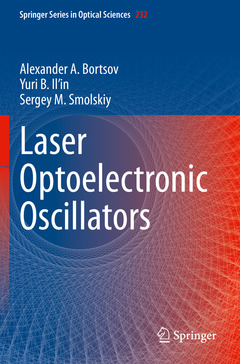Description
Laser Optoelectronic Oscillators, 1st ed. 2020
Springer Series in Optical Sciences Series, Vol. 232
Language: English
Publication date: 09-2021
522 p. · 15.5x23.5 cm · Paperback
Publication date: 09-2020
522 p. · 15.5x23.5 cm · Hardback
Description
/li>Contents
/li>Biography
/li>Comment
/li>
This book is devoted to the theoretical and experimental investigation of the optoelectronic oscillator (OEO) with direct and external modulation of laser emission. Such devices, sources of precision radio frequency oscillations using laser excitation, are novel and technologically relevant, with manifold possible applications. The book includes a review of the present state of the theory and generation techniques in microwave and mm-wave ranges for traditional and optoelectronic oscillators, description of OEO construction and operation principles, theoretical oscillation analysis and mathematical description of the relevant semi-classical laser physics, and investigation of the power spectral density of noises. Technical features and advantages of OEOs with external and direct modulation of laser emission are discussed together with functional diagrams. The characteristics of OEOs are compared with other traditional RF oscillators, such as quartz, surface acoustic waves, and oscillators with electromagnetic wave cavities. Special attention is paid to Q-factors and phase noises of RF carriers at small offsets. The authors discuss the technical characteristics of modern optoelectronic methods for precision RF oscillation formation, such as commercial large-dimension and compact quantum frequency standards with optical pumping on cesium and rubidium cells. This book is aimed at scientists and engineers in academia and industry who work with sources of microwave and mm-wave signals.
Chapter 1. Introduction.- Chapter 2. Nanostructural Optoelectronic Oscillators with the Fiber-Optical Delay Line.- Chapter 3. Modulation Methods of Laser Emission in Optoelectronic oscillator (OEO) and OEO Differential Equations.- Chapter 4. Semiclassical Theory and Laser Differential Equations for Optoelectronic oscillator (OEO) Analysis..- Chapter 5. Optoelectronic oscillator (OEO) Differential Equations as the Laser System with Modulation and Positive Feedback.- Chapter 6. Operation Analysis of Optoelectronic oscillator (OEO) with External Mach–Zehnder Modulator..- Chapter 7. Optoelectronic oscillator (OEO) as the Time and Spatial Correlator of Random Variables with Differential Delay Line.- Chapter 8. Experimental Investigations and Practical Circuits of Optoelectronic oscillator (OEO) with RF FODL
Alexander A. Bortsov was born in Moscow, completed his Ph.D. in Engineering, and graduated from MPEI. His Ph.D. thesis was on the theme “Optoelectronic oscillator with the QW laser diode” in 2005. He is the author of more than 40 scientific publications, among them 30 scientific papers, one book Quantum Opto-Electronic Oscillator, 3 USSR copyright certificates on invention, 4 Russian patents, and more than 20 technological reports on various conferences, including international ones. He was the first in Russia, who in 2004–2005 had got the generation of the optoelectronic oscillator with direct modulation in the microwave range (more than 8 GHz) and investigated of it experiment tally and theoretical in his Ph.D. thesis (2005). He is the first researcher in Russia in 2008–2009 to investigate the opto-electronic oscillator with the Mach–Zehnder modulator in the microwave range 8–10 Ghz. He delivers lectures to students on the fundamentals of the quantum electronics andquantum physics. He trains students in the probabilities theory, mathematical statistics, and many areas of the higher mathematics including mathematical methods of modeling in the MatLab system. Fields of current research: opto-electronic oscillator, photonics, lasers, QW lasers, phase noise, the probabilities theory, mathematical statistics, calculation methods in MatLab.
Yuri B. Il’in, born in 1939, Ph.D. in Engineering. Professional education: Moscow State Mining University, Electromechanical Faculty (1958–1959)/Moscow Power Engineering Institute (National Technical University), Radio Engineering Faculty (1959–1964)/Moscow State University, Faculty of Mechanics and Mathematics (1964–1968). He graduated from Radio Engineering Faculty of MPEI since 1964 just after graduation before he left this institute of his own accord in 1997. At the beginning, he worked on Department of Radio Transmitting Devices, where engaged in the construction of masers, and th
These books may interest you

Applications of Modern RF Photonics 173.00 €

RF microelectronics 104.84 €


